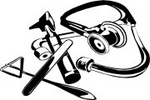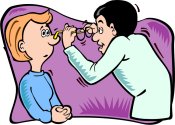
Worksheets and No Prep Teaching Resources
Reading Comprehension Worksheets
Medical Tools

Medical Tools
 Worksheets and No Prep Teaching Resources Reading Comprehension Worksheets Medical Tools |
 Medical Tools |
| edHelper's suggested reading level: | grades 4 to 6 | |
| Flesch-Kincaid grade level: | 7.03 |
|
Why, Eye? Why? - The Story Behind Corrective Lenses
By Jennifer Kenny |

|
 1 All eyes have certain parts. Eyes can be different in certain respects as well. Do you have blue eyes, brown eyes, or hazel eyes? That colored part of the eye is the iris. The center part, which appears to be a black dot, is called the pupil, and it lets light into the eye. The cornea is the clear tissue covering the pupil and iris, and it helps the eye focus. Finally, the retina is at the very back of the eye.
1 All eyes have certain parts. Eyes can be different in certain respects as well. Do you have blue eyes, brown eyes, or hazel eyes? That colored part of the eye is the iris. The center part, which appears to be a black dot, is called the pupil, and it lets light into the eye. The cornea is the clear tissue covering the pupil and iris, and it helps the eye focus. Finally, the retina is at the very back of the eye. |
Create Weekly Reading Books
Prepare for an entire week at once! |
| Leave your feedback on Why, Eye? Why? - The Story Behind Corrective Lenses (use this link if you found an error in the story) |
 |
Medical Tools
|